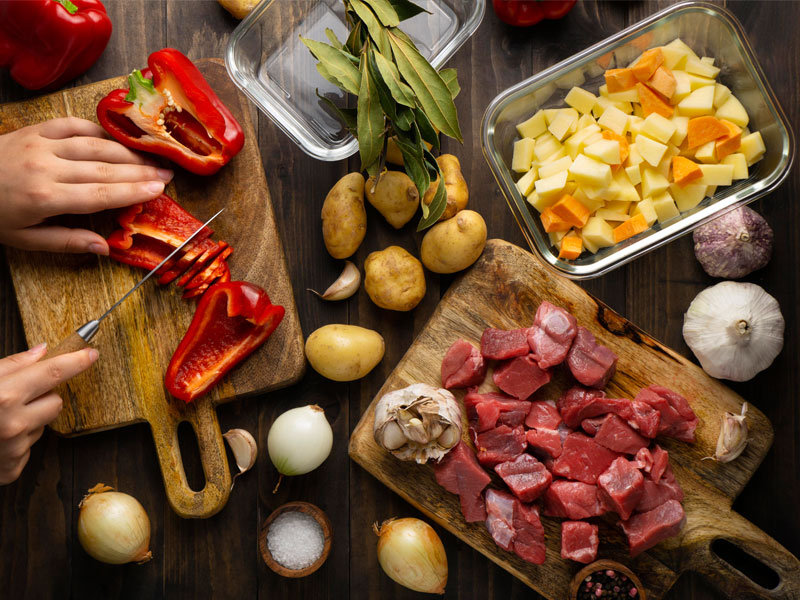The Filipino family's guide to planning healthier, heartier meals

An expert who worked with the country's fastest growing health app mWell in creating nutrition programs and calorie-controlled recipes talks about boosting your immunity with proper meal planning post-pandemic.
MANILA, Philippines — Family mealtime has become the norm as many people are staying home in order to stay safe. However, even before the family gathers around the table again, there is always the challenge of what to cook next. It is a common dilemma that homemakers face daily, especially when repetitive dining options inevitably lead to new cravings.
Having a meal plan might just be the most practical approach to this problem, nutrition expert Shalom Bautista-Sulit, RND suggests. “Practicing meal planning helps to limit their exposure outside their home. By planning meals and snacks, the family can save money, reduce food waste, and limit trips to the grocery store. It can help families be prepared in case there are changes in the quarantine restrictions, by making sure you have everything at home.”
Planning meals also ensures a more balanced nutrition for the family especially with the inclusion of fruits and vegetables on the menu, the expert says.
How to plan your meals
For starters, Bautista-Sulit advises making a one- or two-week meal plan that will include what the family usually eats. “You can also ask the kids what they like, and include that in your list.”
She gives more pointers on planning ahead and making meals healthier all while avoiding food wastage. “Make a kitchen inventory. Start meal planning by using what you have at home first. This will help save money and reduce food waste. Stock some shelf-stable food items to make sure you have access to safe and healthy food just in case you get sick or have to self-isolate,” she says.

“When you have an idea of what you have on hand, list down your meal ideas for breakfast, lunch, dinner, and snacks for the next one to two weeks. While you are listing down your menu and recipes, make sure to include all food groups.”
The next step is to list down what you need from the grocery, to avoid panic buys and missing ingredients.
“Having a grocery list can also help in estimating how much you need to budget,” Bautista- Sulit suggests. “Make it a habit to read labels while shopping. This will help in choosing healthier varieties and cheaper ones. Pay attention to dates on the food labels to make sure you’re not buying items that are close to their expiry dates. Include fresh foods on your shopping list that have longer shelf-life such as carrots, potatoes, squash, apples, lemons, and limes, as well as frozen fruits and vegetables.”
How nutrition changes by age
To help ensure that everyone’s nutritional needs are met in your family meals, Bautista-Sulit also shares a handy health guide for each age group.
For infants up to six months, she says breastmilk is best. When they are ready for solids, she suggests foods rich in iron such as green leafy vegetables, and iron-fortified cereals. “For eight- to 12-month-old babies, parents often only serve purees, when in reality, we can already incorporate food such as vegetables that they can grasp. If you are having tinola, for example, they can just vary the cut of the sayote (chayote) and its tenderness.”
Children should be eating a well-balanced diet, similar to that of an adult, Bautista-Sulit recommends. Count in three meals per day—with one or two healthy snacks consisting of a variety of fruits and vegetables, whole grains, protein source foods, and low-fat dairy, she says.
As teens grow physically, their need for calories and nutrients including protein, calcium, and iron increases. Bautista-Sulit says, “Helping them to develop a positive relationship with food will go a long way in guiding them to become a healthy, self-reliant adult. The best way teens can maintain a healthy weight is to eat a diet rich in whole grains, fruits, vegetables, no-fat or low-fat milk products, beans, eggs, fish, nuts, and lean meats.”
Bautista-Sulit says that adult nutrition can be very challenging as getting older means the body’s ability to use or absorb some nutrients may change. “Calorie requirements and servings for adults vary based on gender, age, and level of physical activity, so not every adult has the same nutritional needs. So for this, what I can recommend best for adults is to know their caloric requirements—and stay within it.”
As people age, they become less active, their metabolism slows down, and their energy requirement decreases. So it’s another story when it comes to the elderly who need to eat less, Bautista-Sulit says. “By adding just a few things to their diet, elderly can avoid losing muscle mass, lessen joint pain and lower their risk of some diseases. Seniors actually need fewer calories, but more nutrient-dense meals with B-12, Vitamin D and calcium.”

How to manage your diet smartly
Staying home and under stress from the uncertainty while keeping busy with work can cause people to crave deep fried food and sweets. “As a dietician, we don’t say this is not allowed,” Bautista-Sulit says. “Anything that is in moderation is okay. If we constantly deprive ourselves of our food cravings, our emotional health may suffer. Comfort food could also help in our mental health, so it's okay in moderation.”
With the convenience of food deliveries, she also reminds people to also be aware that there are healthier choices that we can choose from with these deliveries.
As everyone is also online, Bautista-Sulit cautions people about relying too much on information they see on the internet—especially around diets. “I strongly suggest that before getting into any ‘diet programs,’ it’s better to talk to your doctor first to evaluate your medical concerns and medications. A dietitian can personalize diet programs for you, as there is no one-size-fits-all approach.”
In general, the expert says, it’s all about balancing energy — or the amount of calories eaten versus the amount of calories used by the body. By managing portions, eating a balanced diet from the food groups and not using discretionary calories on high-sugar or high-fat foods, adults can maintain a healthy body together with regular physical activity can help provide better balance.
These days, there are innovative apps that have proven to be helpful and handy in providing information about taking better care of your health through proper diet and nutrition. One of these is Filipino homegrown brand mWell, which has holistic health resources such as nutrition guides prepared by trusted healthcare experts.
Bautista-Sulit, one of the mWell consultants, says, “Filipinos can utilize the mWell PH app as a guide to balanced nutrition, as well as healthy recipes and calorie counting. This can improve the family’s nutritional health.”
PLDT Home—the country’s leading broadband and digital services provider that enables moments that bring the family closer together with its fast connections—has also partnered with mWell in support of the same purpose. Through this partnership, PLDT Home and mWell seek to provide more Filipinos with health and wellness information, and make it easier to consult with medical professionals online.
The mWell PH app not only offers users ease when getting in touch with a doctor. It also provides them with tools to achieve their fitness and wellness goals through free workout plans and the mWellness Score—a free daily health tracker. This breakthrough feature allows users to track their sleep hours, steps and daily activities from their smartphone — no extra gadgets or wearables needed. Anyone can improve their score with easy, simple steps using only their mWell PH app!

Download the mWell PH app at https://mwellph.onelink.me/lnFL/f2747c95 and get access to your mWellness Score and other features for FREE!
For more information on PLDT Home’s partnership with mWell, visit https://pldthome.com/mwell.
- Latest






























